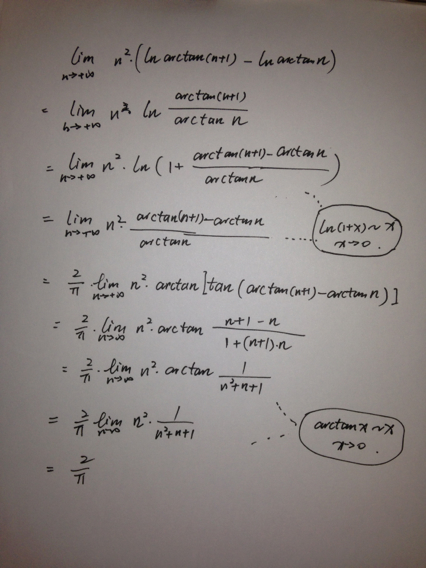lnarctan1/1+x x+1是分母哦,求导.
 nappy01072022-10-04 11:39:541条回答
nappy01072022-10-04 11:39:541条回答
已提交,审核后显示!提交回复
共1条回复
 超级阳光 共回答了23个问题
超级阳光 共回答了23个问题 |采纳率91.3%- (lnarctan1/(x+1)
=1/arctan1/(x+1) * [arctan1/(x+1)]'
=1/arctan1/(x+1)*[1/(1+(1/(x+1))^2]*(1/(x+1)'
=1/arctan1/(x+1)*(x+1)^2/[(x+1)^2+1]*[-1/(x+1)^2]
=-1/{[(x+1)^2+1]*arctan1/(x+1)} - 1年前
相关推荐
- 求n^2(lnarctan(n+1)-lnarctann)当n趋向于无穷时的极限
 建立新证1年前1
建立新证1年前1 -
 mopfetch 共回答了13个问题
mopfetch 共回答了13个问题 |采纳率100%1年前查看全部
- 高数 拉格朗日定理求极限1.lim x2[lnarctan(ex+1)-arctan ex] x趋近于无穷2.令f(t)
高数 拉格朗日定理求极限
1.lim x2[lnarctan(ex+1)-arctan ex] x趋近于无穷
2.令f(t)=lnarctan t
运用拉格朗日定理
lnarctan(ex+1)-arctan ex = f'(z)[1/arctanz*(1+z2)]
问:要乘以那个f'(z)吗?我感觉要去掉
原极限=lim x2/arctanz*(1+z2) 为什么会等于0 x趋近于无穷
注:x2即x的2次方;ex即e的x次方
x/z为什么等于0 緣逸居士1年前2
緣逸居士1年前2 -
 新进少女3 共回答了19个问题
新进少女3 共回答了19个问题 |采纳率89.5%1.lnarctan(ex+1)-arctan ex = f'(z)[1/arctanz*(1+z2)]
确实不需要要乘以那个f'(z),
其中的错误应该是漏了一个等号,正确的如下
lnarctan(ex+1)-arctan ex = f'(z)=[1/arctanz*(1+z2)]
其中的*表示乘法.
2.你的题目是否也写得有些遗漏,比如lnarctan(ex+1)-arctan ex
是否掉了一个ln ,也漏了一个括号,否则根本看不出你将在哪个区间使用拉格朗日定理,
应该为lnarctan(e(x+1))-lnarctan ex
在 [x,x+1]区间使用拉格朗日定理,从而x趋近于无穷 时 x/z 的绝对值小于1,进而lim( x/z)^2=0 ,lim(1/z)^2=0
3.lim x2/arctanz*(1+z2) =lim x2/(1+z2)*1/arctanz
=lim( x/z)^2/ (1/z)^2+1 *1/arctanz
其中lim( x/z)^2=0 ,lim(1/z)^2=0,故lim( x/z)^2/ (1/z)^2+1 =0
另外1/arctanz 为有界量
故原极限=lim x2/arctanz*(1+z2) =0
不知是否讲清了,但愿你能看懂!1年前查看全部
大家在问
- 1彤云密布的造句
- 2杨柳()优美括号内填姿势还是姿态呢?
- 3彩霞前边加一个[4个字]的表示颜色的词语
- 4人们为什么说桂林山水甲天下课文的问题(四年级下学期)
- 53x+5.5=11.5 0.5x+15=21 7.5x-24.5=22 5x/4=10.5
- 6If it were not for his wife's money he'd never be a director
- 7感念师恩,谁来帮我解答
- 8组词又大又圆
- 9很简单的一道化学反应题如何使NaCl一步反应生成HCl?给出方程式…谢谢
- 10设x是实数,y=|x-1|+|x+1|.下列四个结论:
- 11一道化学基础题98%的浓硫酸的密度为1.84g/ml,1.弄就算的物质的量浓度为___________.2.若将该浓硫酸
- 12赵阳赵阳同学家里有一只电热器,他想知道这个电热器工作时的电功率有多大.他把家中其他用电器都关闭,
- 13(2007•厦门)已知:如图,PA、PB是⊙O的切线;A、B是切点;连接OA、OB、OP,
- 14一个根的判别式问题今天看书上有这样一个做法,方程5x^4+6ax^2+3b=0,已知3a^2-5b
- 15为了增强效果,广告词往往也运用各种修辞手法。下列广告修辞手法辨别正确的一项是

